Venetian glass
Venetian glass (Italian: vetro veneziano) is thought to have been made for over 1,500 years, and production has been concentrated on the Venetian island of Murano since the 13th century. Today Murano is known for its art glass, but it has a long history of innovations in glassmaking in addition to its artistic fame—and was Europe's major glassmaking center from the Middle Ages through the Renaissance. During the 15th century, Murano glassmakers created cristallo—which was almost transparent and considered the finest glass in the world. Murano glassmakers also developed a white-colored glass (milk glass called lattimo) that looked like porcelain. They later became Europe's finest makers of mirrors.
.jpg.webp)
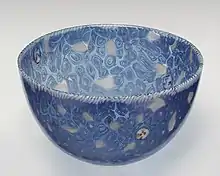
Originally, Venice was controlled by the Byzantine Empire, but it eventually became an independent city state. It flourished as a trading center and seaport. Its connections with the Middle East helped its glassmakers gain additional skills, as glassmaking was more advanced in areas such as Syria and Egypt. Although Venetian glassmaking in factories existed as far back as the 8th Century, it became concentrated in Murano by law, beginning in 1291. Since glass factories often caught fire, this removed much of the possibility of a major fire disaster for the city. Venetian glassmakers developed secret recipes and methods for making glass, and the concentration of Venice's glassmaking on the island of Murano enabled better control of those secrets.
Murano became Europe's elite glassmaking center, peaking in popularity in the 15th and 16th centuries. Venice's dominance in trade along the Mediterranean Sea created a wealthy merchant class that was a strong connoisseur of the arts. This helped establish demand for art glass and more innovations. The spread of glassmaking talent in Europe eventually diminished the importance of Venice and its Murano glassmakers. The occupation and dissolution of the Venetian state by Napoleon Bonaparte in 1797 caused more hardship for Murano's glassmaking industry. Murano glassmaking began a revival in the 1920s. Today, Murano and Venice are tourist attractions, and Murano is home to numerous glass factories and a few individual artists' studios. Its Museo del Vetro (Glass Museum) in the Palazzo Giustinian contains displays on the history of glassmaking as well as glass samples ranging from Egyptian times through the present day.
Background
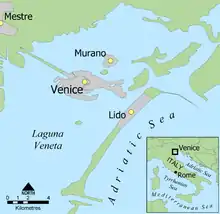
The Venetian city state grew during the decline of the Roman Empire as people fled barbarian invasions to the safety of islands in the Venetian Lagoon. Small communities grew in the lagoon, and Venice became the most prominent. The city of Venice became a highly successful trading port, and by the 11th century dominated trade between Europe, North Africa, and the Middle East. It also had a strong navy. Many European Crusaders passed through Venice on their way to and from the Holy Land. Treasures of many kinds were bought and sold in Venice: spices, precious metals, gemstones, ivory, silks—and glass. Successful trade bred a wealthy merchant class in addition to the nobles, and the wealthy became patrons of Venice's famous art and architecture.[1]
It is thought that glass production in Venice began around 450, as glassmakers from Aquileia fled to the islands to escape barbarian invaders.[Note 1] The earliest archaeological evidence of a glass factory in the area comes from the Venetian lagoon island of Torcello and dates from the 7th to 8th century.[5] The original Venetian glassmakers were joined by glassmakers from Byzantium and from the Middle East—which enriched their glassmaking knowledge.[4] Glass was made in the Middle East long before it was made in Europe, though Ancient Roman glass made in Italy, Germany and elsewhere could be extremely sophisticated.[Note 2] Early products included beads, glass for mosaics, jewelry, small mirrors, and window glass.[8]
Venetian glassmaking grew in importance to the city's economy. Around 1271 the local glassmakers' guild made rules to help preserve glassmaking secrets. It was forbidden to divulge trade secrets outside of Venice. If a glassworker left the city without permission, he would be ordered to return.[Note 3] If he failed to return, his family would be imprisoned. If he still did not return, an assassin would be sent to kill him. Additional rules specified ingredients used for making glass and the type of wood used as fuel for the furnaces.[10]
Island of Murano
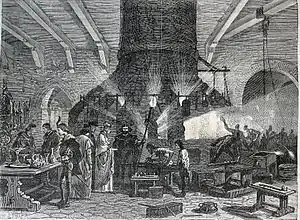
A law dated November 8, 1291 confined most of Venice's glassmaking industry to the "island of Murano".[11] Murano is actually a cluster of islands linked by short bridges, located less than 2 kilometres (1.2 mi) north of the Venetian mainland in the Venetian lagoon.[Note 4] The furnaces used to make molten glass were a fire hazard, especially in cities with wooden structures nearby. Moving the glassmaking industry to Murano removed the threat of a disastrous fire in Venice. The move also kept the technology of glassmaking, and the glassmakers, confined to Murano. This prevented the spread of Venetian glassmaking expertise to potential competitors. Glassmakers were not allowed to leave the island without permission from the government. Leaving without permission, or revealing trade secrets, was punishable by death. Locating the industry on a single island also made it easier for the government to monitor imports and exports.[13]
Murano in the 1200s was a summer resort where the aristocrats of Venice built villas with orchards and gardens. It took about an hour to row a boat from Venice to Murano.[15] Although the glassmakers could not leave the island, the nobles had no such constraints. Despite their travel restrictions, the glassmakers lived on a beautiful island, were under the direct rule of Venice's Council of Ten (the Venetian state-security committee), and had extra privileges.[16] They did not work during the hot summer, during which furnace repair and maintenance was performed.[17] During the 1300s, the annual summer vacation lasted five months.[18] In the 1400s, the Venetian government shortened the summer vacation to three and a half months.[19] Murano glassmakers sometimes complained they were not working enough.[Note 5] Glassmakers also enjoyed heightened social status. On December 22, 1376, it was announced that if a glassmaker's daughter married a nobleman, there was no forfeiture of social class, so their children were nobles.[21]
Major products and innovations

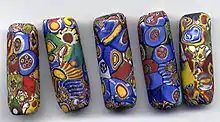

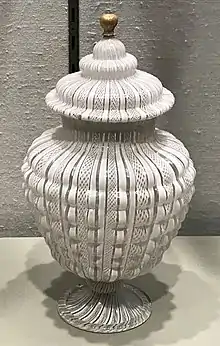
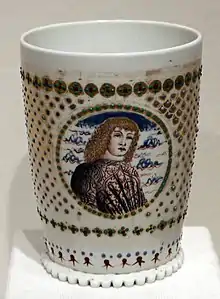
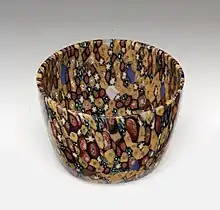
The Venetian glassmakers of Murano are known for many innovations and refinements to glassmaking. Among them are Murano beads, cristallo, lattimo, chandeliers, and mirrors.[13] Additional refinements or creations are goldstone, multicolored glass (millefiori), and imitation gemstones made of glass.[22] In addition to guarding their secret processes and glass recipes, Venetian/Murano glassmakers strived for beauty with their glass.[23]
Aventurine
Aventurine glass, also known as goldstone glass, is translucent brownish with metallic (copper) specks. It was developed by Venetian glassmakers in the early 15th century.[24] It is first cited in historical documents in 1626.[25] The name aventurine is used because it was discovered accidentally.[25]
Beads
Glass beads (a.k.a. Murano beads) were made by the Venetians beginning in the 1200s. The beads were used as rosary beads and jewelry. They were also popular in Africa. Christopher Columbus noted that the people of the New World (Native Americans) were "delighted" with the beads as gifts, and beads became popular with American Indians.[26]
Calcedonio
Calcedonio is a marbled glass that looked like the semiprecious stone chalcedony.[27] This type of glass was created during the 1400s by Angelo Barovier, who is considered Murano's greatest glassmaker.[28] Barovier was an expert glassblower, revived enameling, and also worked with colored glass. His family had been involved with glassmaking since at least 1331, and the family continued in the business after his death.[29] He died in 1460.[Note 6]
Chandeliers
During the 1700s, Giuseppe Briati was famous for his work with ornamented mirrors and chandeliers.[23] Briati's chandelier style was called ciocche—literally bouquet of flowers. Briati's typical chandelier was large with multiple arms decorated with garlands, flowers and leaves. One of the common uses of the huge Murano chandeliers was interior lighting for theatres and important rooms in palaces. Briati was born in Murano in 1686, and his family's business was glassmaking. He was allowed to work in a Bohemian glass factory, where he learned the secrets of working with Bohemian crystal—which was becoming more popular than Murano cristallo. In 1739, the Council of Ten allowed him to move his furnace from Murano to Venice because his work had caused such jealousy that he and his workers feared for their lives. (His father had been stabbed to death in 1701.)[32] Briati retired in 1762, and his nephew became manager of the glass works. Briati died in Venice in 1772, and is buried in Murano.[33]
Cristallo
Cristallo is a soda glass, created during the 15th century by Murano's Angelo Barovier.[Note 7] The oldest reference to cristallo is dated May 24, 1453.[9] At the time, cristallo was considered Europe's clearest glass, and is one of the main reasons Murano became "the most important glass center".[13] It looked like quartz, which was said to have magical qualities and often used in religious objects. Cristallo became very popular.[31] This type of glass was fragile and difficult to cut, but it could be enameled and engraved.[36] Manganese was a key ingredient in the secret formula used to make cristallo.[8] An easy modification to cristallo made in Murano was to produce a frosted or crackle version.[37]
Filigrana
The filigrana (a.k.a. filigree) style was developed in Murano in the 1500s. By embedding glass canes (usually white but not always) in colorless glass, the glassware has a striped appearance. Vetro a fili has straight white stripes, vetro a retortoli has twisted or spiral patterns, and vetro a reticello has two sets of lines twisted in opposite directions. Francesco Zeno has been mentioned as the inventor of vetro a retortoli.[38]
Lattimo
Lattimo, or milk glass, began being made in Murano during the 15th century, and Angelo Barovier is credited with its re-discovery and development.[39] This glass is opaque white, and was meant to resemble enameled porcelain.[40] It was often decorated with enamel showing sacred scenes or views of Venice.[41]
Millefiori
Millefiori glass is a variation of the murrine technique made from colored canes in clear glass, and is often arranged in flower-like patterns. The Italian word millefiori means thousand flowers.[24] This technique was perfected in Alexandria, Egypt, and began being used in Murano in the 15th century.[42]
Mirrors
Small mirrors were made in Murano beginning in the 1500s, and mirror makers had their own guild beginning in 1569.[43] Murano mirrors were known for the artwork on the frame that held the mirror in addition to their quality.[43] By the 1600s, Murano mirrors were in great demand. However, by the end of the century, English-made mirrors had the best quality. Only one glass house in Murano was still making mirrors by 1772.[44]
Murrine
Murrine technique begins with the layering of colored liquid glass, heated to 1,040 °C (1,900 °F), which is then stretched into long rods called canes. When cooled, these canes are then sliced in cross-sections, which reveals the layered pattern. Ercole Barovier, a descendant of Murano's greatest glassmaker Angelo Barovier, won numerous awards during the 1940s and 1950s for his innovations using the murrine technique.[45]
Sommerso
Sommerso ("submerged" in Italian), is a form of artistic Murano glass that has layers of contrasting colors (typically two), which are formed by dipping colored glass into another molten glass and then blowing the combination into a desired shape. The outermost layer, or casing, is often clear. Sommerso was developed in Murano during the late 1930s. Flavio Poli was known for using this technique, and it was made popular by Seguso Vetri d'Arte and the Mandruzzato family in the 1950s. This process is a popular technique for vases, and is sometimes used for sculptures.[45]
Golden age, decline, and revival
.jpg.webp)
The 16th century was the golden age for Venetian glassmaking in Murano. Major trading partners included the Spanish Indies, Italy, Spain, Ottoman Turkey, and the German-speaking states.[46] At least 28 glassmaking furnaces were in Murano in 1581.[47] Numerous leaders and dignitaries visited Murano during this century, including the queen of France, dukes, princes, generals, cardinals, archbishops, and ambassadors.[48] Collectors of Murano glass included Henry VIII of England, Pope Clement VII, King Ferdinand of Hungary, Francis I of France, and Phillip II of Spain.[49]
Eventually, the dominance of cristallo came to an end. In 1673, English glass merchant George Ravenscroft created a clear glass he called crystalline—but it was not stable. Three years later, he improved this glass by adding lead oxide, and lead glass (a.k.a. crystal) was created.[50] Ravenscroft, who had lived for many years in Venice, made lead crystal that was less breakable than cristallo.[51] In 1674, Bohemian glassmaker Louis Le Vasseur made crystal that was similar to Ravenscroft's.[52] In 1678, Johan Friedrich Kunkel von Lowenstein produced a cristallo-like glass in Potsdam.[53] The Bohemian and Prussian-style glass was later modified by the addition of lime and chalk. This new glass is attributed to Bohemian glassmaker Michael Müller in 1683.[53] The Bohemian glass was not suitable to the Murano-style artwork on the glass. However, this harder glass was produced as a thicker glass suitable for engraving and grinding. The Bohemian and English glass eventually became more popular than cristallo made in Murano.[53] By the 1700s, Murano glass was traded mostly with Italian states and the Turkish empire. Small quantities were traded with England, Flanders, the Netherlands and Spain.[54]
Napoleon conquered Venice during May 1797, and the Venetian Republic came to an end.[55] The fall of the Venetian Republic caused hard times for glassmaking in Murano, and some of the Murano methods became lost. Controlled by France and Austria, Venetian glassmaking became unprofitable because of tariffs and taxes—and glassmakers that survived were reduced to making mostly beads.[56] Napoleon closed the Venetian glass factories in 1807, although simple glassware and beadmaking continued.[57] In the 1830s, outsiders tried to revive the industry.[23] However, it was not until Venice became part of Italy in 1866 that Murano glassmaking could experience a revival.[56] Around that time, local leaders such as Abbot Vincenzo Zanetti (founder of the Murano Glass Museum), along with the Murano factory owners, began reinventing the earlier Murano techniques for making glass.[57] Antonio Salviati, a Venetian lawyer who gave up his profession in 1859 in order to devote his time to glassmaking, also had an important role in the revival of glassmaking in Murano.[58]
Making glass
From its beginning until the fall of the Venetian Republic, Murano glass was mostly a very high quality soda lime glass (using today's terminology) that had extra attention focused on its appearance. Glass from that time typically contained 65 to 70 percent silica.[59] A flux, usually soda (sodium oxide as 10 to 20 percent of the glass composition) was added to enable the silica to melt at a lower temperature. A stabilizer, usually lime (calcium oxide as about 10 percent of the glass) was also added for durability and to prevent solubility in water. Small quantities of other ingredients were added to the glass, mostly to affect appearance.[60] Sand is a common source for silica. For certain types of glass, the Murano glassmakers used quartz as their source for silica. Quartz pebbles were crushed into a fine powder. Two sources for sand were Creta and Sicily. Quartz pebbles were selected from the Ticino and Adige rivers in Northern Italy.[61] Their source for soda was what they called allume catina—plant ash found in the eastern Mediterranean countries of the Middle East.[59] Beginning in the 16th century, allume catina was also imported from Mediterranean coastal regions of Spain and France.[61]
The mixing and melting of the batch of ingredients was a two-stage process. First, nearly equal amounts of silica and flux were continuously stirred in a special furnace. The furnace was called a calchera furnace, and the mix was called fritta. In the second stage, the fritta was mixed with selected recycled waste glass (cullet) and melted in another furnace.[62] Depending on the type and color of glass, other additives were used. Lead and tin were added for white opaque glass (latimo). Cobalt was used for blue glass. Copper and iron were used for green and for various shades of green, blue, and yellow.[63] Manganese was used to remove colors.[64] Although natural gas is the furnace fuel of choice for glassmaking today, the fuel mandated in Murano during the 13th century was alder and willow wood.[5] During this second stage, the surface of the molten glass was skimmed to remove undesirable chemicals that affected the appearance of the glass.[62] Additional techniques were used as glassmaking evolved. To improve clarity, molten glass was put in water and then re-melted. Another technique was to purify the flux by boiling and filtering.[60]
Tools
The Venetian glassmakers had a set of tools that changed little for hundreds of years. A ferro sbuso, also called a canna da soffio, is the blowpipe essential for extracting molten glass and beginning the shaping process.[65] A borselle is a tong-like tool of various sizes used to shape glass that has not hardened. A borselle puntata is a similar tool, only it has a pattern that can be imprinted on the glass.[66] A pontello is an iron rod that holds the glass while work is done on the edge of the glass.[19] A tagianti is a large scissors used to cut glass before it has hardened. A scagno is the workbench used by the glassmaker.[67] "Good tools are nice, but good hands are better," is an old Murano saying that reinforces the idea that the glassmakers of Murano rely on their skills instead of any advantage caused by special tools.[68]
Today
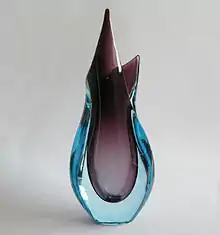

Some of Venice's historical glass factories in Murano remain well known brands today, including De Biasi, Gabbiani, Venini, Salviati, Barovier & Toso, Pauly, Berengo Studio, Seguso, Formia International, Simone Cenedese, Alessandro Mandruzzato, Vetreria Ducale, Estevan Rossetto 1950 and others. The oldest glass factory is Antica Vetreria Fratelli Toso, founded in 1854.[69]
Overall, the industry has been shrinking as demand has waned. Imitation works (recognizable by experts but not by the typical tourist) from Asia and Eastern Europe take an estimated 40 to 45 percent of the market for Murano glass, and public tastes have changed while the designs in Murano have largely stayed the same. To fight the imitation problem, a group of companies and concerned individuals created a trademark in 1994 that certifies that the product was made on Murano. By 2012, about 50 companies were using the Artistic Glass Murano® trademark of origin.[70]
Glassmaking is a difficult and uncomfortable profession, as glassmakers must work with a product heated to extremely high temperatures. Unlike 500 years ago, children of glassmakers do not enjoy any special privileges, extra wealth, or marriage into nobility. Today, it is difficult to recruit young glassmakers. Foreign imitations, and difficulty attracting young workers, caused the number of professional glassmakers in Murano to decrease from about 6,000 in 1990 to fewer than 1,000 by 2012.[70]
See also
Notes
Footnotes
- There are two main theories about the beginning of Venetian glassmaking. One is that glassmaking began as glassmakers from Aquileia arrived after fleeing barbarian invasions during the fifth century.[2] A 19th century author credits Italian writers Carlo Marin and the Count Filiasi for this idea.[3] Shotwell supports this theory and uses the year 450 as the approximate start date.[4] A second theory is that Venetian glassmaking developed from Venetian interaction and trade with the Levant (Eastern Mediterranean).[2] Janssens says that "similarities in techniques and forms between Venetian glass and Byzantine and Islamic glass are evident".[2]
- The region between the Tigris and Euphrates rivers is considered the birthplace of glassmaking. Glass was made there before 2000 B.C.[6] Glass was made in Syria as far back as 1700 B.C., and around 100 B.C. the Syrians started glassblowing.[7]
- While the Murano glassmakers were typically men, records exist beginning in the 1400s of women working in the manufacture of glass in Murano. A record from 1446 describes the employment of a woman who decorated glass and worked for Salvatore Barovier.[9]
- Dugan and Shotwell describe Murano as a group of small islands connected by bridges.[12][13] The official Murano glass shop says Murano is 1.5 kilometres (0.93 mi) from Venice.[14]
- In the 1540s, the Murano glassmakers were unhappy with the 35-week work year, complaining that they did not get enough time to work—contrary to typical complaints of too much work.[20]
- At least three authors agree that Angelo Barovier died in 1460.[9][30] The date of his birth is less certain, but is said to be around 1400.[31]
- Angelo Barovier is generally credited with creating cristallo, and was definitely making it in 1455.[34] One set of authors believes that cristallo was an incremental "development that stretched over nearly two centuries."[35] They speculate that Barovier perfected the soda ash purification process used for cristallo, and also discovered the stabilizer.[35]
Citations
- Zerwick 1990, p. 49
- Janssens 2011, p. 520
- Sauzay 1870, p. 20
- Shotwell 2002, p. 586
- Toso 2000, p. 25
- Shotwell 2002, p. 343
- Shotwell 2002, p. 546
- Shotwell 2002, p. 587
- Toso 2000, p. 46
- Shotwell 2002, pp. 586–587
- United States Bureau of Foreign and Domestic Commerce 1917, p. 789
- Dugan 2019, p. 123
- Shotwell 2002, p. 366
- "Murano Island". MuranoGlassItaly. MuranoGlassItaly Store. Retrieved 2020-02-01.
- Zerwick 1990, pp. 49–50
- Moore 1935, p. 31
- Dillon 1907, p. 182
- Toso 2000, p. 37
- Toso 2000, p. 45
- Moore 1935, p. 33
- Toso 2000, p. 40
- Geary 2008, p. 202
- "Ancient and Modern Venetian Glass of Murano". Harper's New Monthly Magazine. New York: Harper and Brothers. 1882-01-01. Retrieved 2018-09-26.
- Shotwell 2002, p. 24
- Toso 2000, p. 97
- Zerwick 1990, pp. 50–51
- Hess, Husband & J. Paul Getty Museum 1997, p. 90
- Chambers et al. 1999, p. 21
- McCray 2017, chapter 5 of e-book
- Shotwell 2002, p. 30
- Chambers et al. 1999, p. 22
- Toso 2000, pp. 122–124
- Toso 2000, p. 127
- Moore 1935, p. 37
- Syson & Thornton 2001, p. 186
- Shotwell 2002, p. 110
- Dillon 1907, p. 203
- Page & Doménech 2004, p. 18
- Hess, Husband & J. Paul Getty Museum 1997, p. 73
- Shotwell 2002, p. 294
- Fuga 2006, p. 257
- Fuga 2006, p. 282
- Shotwell 2002, p. 351
- Moore 1935, p. 48
- "1950s Glassware Reflects Distinct Era". Annapolis Capital. 1999-02-19. p. 123.

- Toso 2000, p. 61
- Toso 2000, p. 62
- Toso 2000, p. 64
- Toso 2000, p. 66
- Toso 2000, p. 102
- Zerwick 1990, p. 65
- Toso 2000, p. 103
- Toso 2000, p. 105
- Toso 2000, p. 109
- Madden 2012, p. Ch. 17 of e-book
- "Authenticity of Venetian Glass Sometimes Tough to Distinguish". Capital Entertainment (Annapolis, MD). 1998-09-11. p. 15.

- "A Comparison of Earlier and Later Venetian Glass - A Question of Continuity". Corning Museum of Glass. Retrieved 2018-09-28.
- Edwards, Sommerfield & National Gallery of Victoria 1998, p. 150
- Janssens 2011, p. 26
- Janssens 2011, p. 528
- Janssens 2011, p. 524
- Janssens 2011, p. 523
- Janssens 2011, pp. 531–532
- Janssens 2011, p. 526
- Mentasti 1997, p. 188
- Shotwell 2002, p. 48
- Dorigato 2003, p. 31
- "Tools of the Glassmaker". Corning Museum of Glass. Retrieved 2018-09-30.
- Gable 2004, p. 44
- Hooper, John (2012-01-30). "Glassmakers of Murano Fight to Survive Influx of Cheap Imitations". The Guardian. The Guardian (2012-01-30). Retrieved 2018-09-03.
References
- Chambers, Karen S.; Oldknow, Tina; Ft. Wayne Museum of Art; Tampa Museum of Art (1999). Clearly Inspired : Contemporary Glass and Its Origins. San Francisco: Pomegranate. p. 134. ISBN 978-0-76490-932-0. OCLC 1008387303.
- Dillon, Edward (1907). Glass. London: Methuen and Co. pp. 373. OCLC 1809307.
- Dorigato, Attilia (2003). Murano, Island of Glass. Arsenale Editrice (IT). ISBN 978-8-87743-293-3. OCLC 156146832.
- Dugan, James (2019). Capturing Venice. Walkabout photo guides.
- Edwards, Geoffery; Sommerfield, Garry; National Gallery of Victoria (1998). Art of Glass: Glass in the Collection of the National Gallery of Victoria. South Melbourne: Macmillan. p. 208. ISBN 978-0-95857-431-0. OCLC 1008129059.
- Fuga, Antonella (2006). Artists' techniques and materials. Los Angeles: J. Paul Getty Museum. p. 384. ISBN 978-0-89236-860-0. OCLC 64486684.
- Gable, Carl I. (2004). Murano Magic: Complete Guide to Venetian Glass, Its History and Artists. Atglen, PA: Schiffer Pub. ISBN 978-0-76431-946-4. OCLC 53361383.
- Geary, Theresa Flores (2008). The Illustrated Bead Bible. New York: Sterling. ISBN 978-1-4027-2353-7.
- Hess, Catherine; Husband, Timothy; J. Paul Getty Museum (1997). European Glass in the J. Paul Getty Museum. Los Angeles: The Museum. ISBN 978-0-89236-255-4. OCLC 36549048.
- Janssens, Koen H. A. (2011). Modern Methods for Analyzing Archaeological and Historical Glass. Chichester, West Sussex, United Kingdom: John Wiley & Sons Inc. ISBN 978-1-11831-420-3. OCLC 1042124312.
- Madden, Thomas F. (2012). Venice: A New History. New York: Viking Penguin. ISBN 978-1-10160-113-6.
- McCray, W. Patrick (2017). Glassmaking in Renaissance Venice: The Fragile Craft. Taylor & Francis Ltd. ISBN 978-0-75460-050-3.
- Mentasti, Rosa Barovier (1997). Venetian Glass: 1890-1990. Venice: Arsenale Editrice. p. 207. ISBN 978-8-87743-119-6. OCLC 232969210.
- Moore, N. Hudson (1935). Old Glass - European and American. New York: Tudor Publishing Co. p. 394. OCLC 1189068.
- Page, Jutta-Annette; Doménech, Ignasi (2004). Beyond Venice: Glass in Venetian Style, 1500-1750. New York: Corning Museum of Glass. p. 339. ISBN 978-0-87290-157-5. OCLC 55110404.
- Sauzay, Alexandre (1870). Marvels of Glass-Making in All Ages. London: S. Low, Son, and Marston. pp. 272. OCLC 5207106.
- Shotwell, David J. (2002). Glass A to Z. Iola, WI: Krause Publications. pp. 638. ISBN 978-0-87349-385-7. OCLC 440702171.CS1 maint: ref=harv (link)
- Syson, Luke; Thornton, Dora (2001). Objects of Virtue : Art in Renaissance Italy. Los Angeles: J. Paul Getty Museum. p. 288. ISBN 978-0-89236-657-6. OCLC 264966212.
- Toso, Gianfranco (2000). Murano : A History of Glass. Antique Collectors Club Limited. p. 191. ISBN 978-8-87743-215-5. OCLC 449936626.
- United States Bureau of Foreign and Domestic Commerce (1917). Commerce Report. Washington, DC: U.S. Department of Commerce. OCLC 16914088.
- Zerwick, Chloe (1990). A Short History of Glass. New York: H.N. Abrams in association with the Corning Museum of Glass. p. 112. ISBN 978-0-81093-801-4. OCLC 20220721.
Further reading
- Barovier, Marino; Sonego, Carla (2004). Venetian Art Glass: An American Collection, 1840-1970. Stuttgart: Arnoldsche. p. 352. ISBN 978-3-89790-205-3. OCLC 56447139.
- Heiremans, Marc (2002). Murano Glass: Themes and Variations. Stuttgart: Arnold. p. 223. ISBN 978-3-89790-163-6. OCLC 248786059.
- McFadden, David Revere; Barovier, Marino; Frantz, Susan K. (2001). Venetian Glass. New York: American Craft Museum. pp. 249. ISBN 978-1-89038-505-7. OCLC 123123380.
- Panini, Augusto (2017). The World in a Bead. The Murano Glass Museum's Collection. Antiga Edizioni. p. 375. ISBN 978-8-89965-790-1. OCLC 1001512112.
- Piña, Leslie (2004). Fratelli Toso: Italian Glass 1854-1980. Atglen, PA: Shiffer Pub. p. 224. ISBN 978-0-76432-026-2.
- Piña, Leslie (2007). Archimede Seguso: Lace and Stone: Mid-Mod Glass from Murano. Atglen, PA: Shiffer Pub. p. 223. ISBN 978-0-76432-661-5. OCLC 74029385.
- Sonego, Carla (2017). Paolo Venini and His Furnace. Milano: Skira Editore. p. 532. ISBN 978-8-85723-354-3. OCLC 1003587576.
External links
| Wikimedia Commons has media related to Murano glassware. |
| Wikimedia Commons has media related to Venetian glassware. |
- A History of Murano Glass
- Corning Museum of Glass - The Rise of Venetian Glassmaking
- The Heart of Venice: International Competition for Ideas
- List of glass factories on Murano
- Muranoglass.com
- Murano Glass Museum (English language)
- Primary processing
- Promovetro Consortium
- YouTube Video: The art of Murano glass
- Knowledge about original Murano glass, history, heritage, working technique
